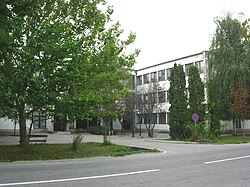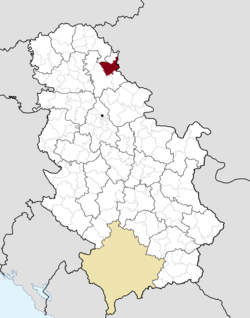Žitište
|
Žitište Житиште |
||
|---|---|---|
| Town and municipality | ||

Building in the town center.
|
||
|
||
 Location of Žitište within Serbia |
||
| Coordinates: 45°29′N 20°33′E / 45.483°N 20.550°ECoordinates: 45°29′N 20°33′E / 45.483°N 20.550°E | ||
| Country |
|
|
| Province | Vojvodina | |
| District | Central Banat | |
| Government | ||
| • Mayor | Dragan Milenković - Democratic Party | |
| Area | ||
| • Žitište | 525 km2 (202.7 sq mi) | |
| Population (2011) | ||
| • Žitište | 2,903 | |
| • Metro | 16,841 | |
| Time zone | CET (UTC+1) | |
| • Summer (DST) | CEST (UTC+2) | |
| Postal code | 23210 | |
| Area code(s) | +381(0)23 | |
| Car plates | ZR | |
| Website | zitiste.org | |
Žitište (Serbian Cyrillic: Житиште; pronounced [ʒîtiːʃte]) is a town and municipality located in the Central Banat District of the autonomous province of Vojvodina, Serbia. The town has a population of 2,898, while Žitište municipality has 16,786 inhabitants.
In Serbian, the town is known as Žitište (Cyrillic: Житиште), in Romanian as Jitiște or Zitiște, in German as Sankt Georgen an der Bega, and in Hungarian as Bégaszentgyörgy or Begaszentgyörgy.
The Serbian name of the town derived from the Serbian word "žito" ("wheat" in English). Its old names used in Serbian were Begej Sveti Đurađ and Senđurađ.
The Hungarian name of the town derived from the Hungarian family name Szentgyörgyi.
Žitište was founded in the 14th century during the administration of the medieval Kingdom of Hungary, under the name of Zenthgyurgh (Szentgyörgyi). In 1660/1666, it was called Senđurađ, which was recorded as a settlement repopulated by ethnic Serbs during Ottoman rule. In the beginning of the 18th century, the settlement was completely abandoned and in 1723 it was recorded as an uninhabited heath.
It was settled again in 1724 by Serb and Romanian settlers. In 1736/37, the settlement had 27 houses. Because of the Austro-Turkish war (1736–1739) and pestilence, the number of inhabitants decreased and in 1740 the population of the settlement numbered 18 houses. In 1753, Begej Sveti Đurađ was settled by 1,000 Serb frontiersmen from Pomorišje, Potisje and Veliki Bečkerek, and in the same year it was recorded on map as a "Serb-inhabited settlement". In 1758, Begej Sveti Đurađ had 45 houses, and in 1773 it had 182 houses. Its church was built in 1758, and it was also used as a school. In 1781, Begej Sveti Đurađ became a property of Isak Kiš (Kis Izsák), who was a trader of Armenian origin.
...
Wikipedia

